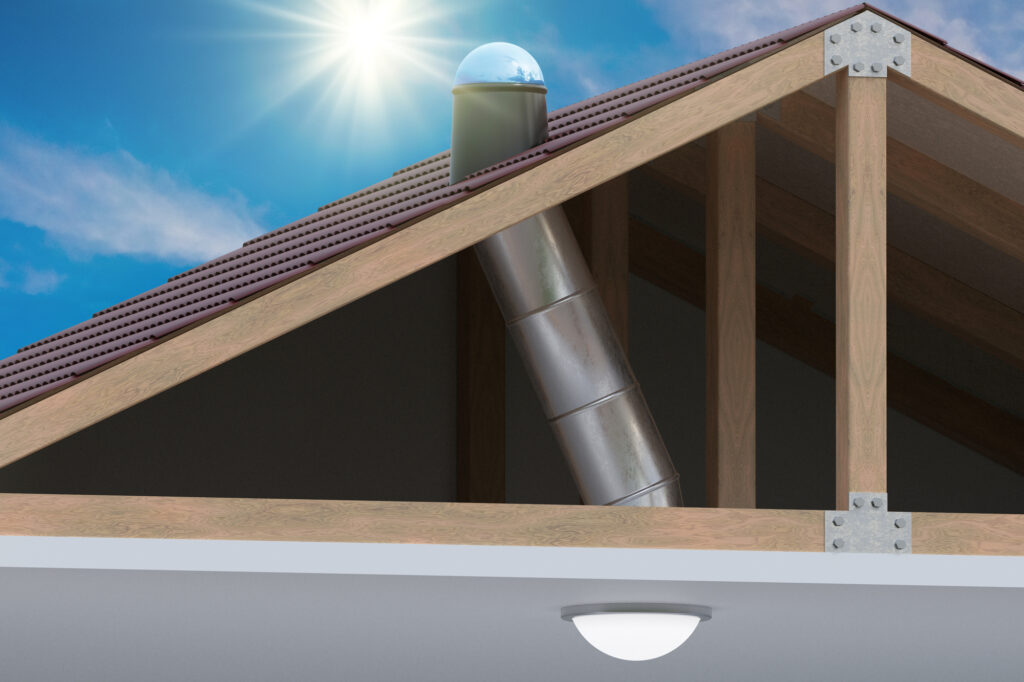An abundance of natural light is typically a coveted feature in any building but especially in homes. To increase existing light or add it to interior rooms without windows, people often turn to skylights for illumination and for other functional and aesthetic purposes. Adding these features often happens in conjunction with roof installations or other roofing services. In addition to traditional window-like skylights, solar tube skylights offer many benefits to the home and might offer a more versatile and durable option for your structure or environment.
What is a solar tube skylight?
Often referred to as tubular skylights, solar tube skylights redirect sunlight from the outside roof to inside spaces that have minimal or non-existent light. In terms of their construction, these sun tubes consist primarily of the rooftop dome, reflective tube, and light diffuser, which make solar tube skylights different from standard skylights. The sun tubes work in a straightforward, but intricate design:
- The weather-resistant dome is made of strong materials to protect the interior components and collect sunlight from multiple directions.
- The highly reflective surface inside of the tube ensures the transmission of as much light as possible into the home.
- The interior domed light fixture is often frosted or prismatic to reduce glare and evenly distribute soft sunlight throughout the connected space.
Why would my home benefit from solar tube installation?
Incorporating light tubes into your home offers multiple benefits. As with window-like skylights, natural light access is increased, and its greater presence often positively impacts the overall environment of the home and personal well-being. In addition, here are some additional reasons that tube skylights might be the ideal choice for your home:
- Less heat: Tubular skylights are smaller than traditional skylights so they result in less heat transfer into the home’s interior. This trait may be especially helpful for avoiding increased cooling costs in the summer months or in locations where higher temperatures are more frequent.
- Smaller space needs: Since they are smaller in size, they may not be as limited by structural configurations or spatial constraints. So, they can be integrated into rooms with a minimal roof coverage and are often easier to incorporate.
- Energy savings: Increase your access to natural light, and decrease inefficient energy use and associated costs that may come with artificial lighting.
- Cost: Depending on desired skylight functions, sun tubes may be a more affordable choice for your budget, since fewer materials and less labor are typically required.
- Style: Aesthetically, these dome shapes or size of these light tunnels may better align with your exterior or interior design preferences.
- Comfort: Light from solar tube installations is diffused. This softer sunlight may be more comfortable for some individuals or more appealing, as it won’t have the same glare or shadow contrast that other skylights may deliver.
- Low maintenance: Both the materials used in the sun tubes and their general design are intended to require minimal maintenance after proper initial installation.
How do tube skylights differ from traditional skylights?
There are many types of skylights and many aspects that go into finding the right skylight for you and your home. From climate to roof design, everything influences the skylight decision making process. To determine if a tube skylight might work for you, consider the pros and cons of these skylights.
- Ventilation: Traditional skylights enable increased air flow throughout the space. This ventilation capability can assist in refreshing inside air and temperature regulation. Tubular skylights do not offer this function.
- Consistent sunlight: Sun tubes are most effective with direct sunlight. Therefore, areas that are typically cloudy or overcast may not experience the benefits of this type of skylight as fully.
- Minimal lighting control: Shades can accompany standard skylights, and artificial lighting has on/off and dimming capabilities. Both light sources provide increased ability to manage light and warmth. These features are not typical of solar tube skylights, but light tunnels already offer more diffuse light with minimal heat increase.
- No scenic views: In addition to ventilation, people often add skylights to be able to enjoy seeing the sky or other scenic views. With a solar tube installation, sun will be drawn in, but the surrounding outdoor environment won’t be visible.
- Placement limitations: Although the size of tubular skylights sometimes makes them the only feasible skylight option in a particular space, they do require directional considerations to maximize light access.
Have you decided that you are interested in further exploring skylights for your home? Here are some tips on choosing a skylight contractor or simply contact the Ranch Roofing team for assistance. In addition to residential and commercial roofing, we also perform skylight installations. If you have any questions about skylights or are looking for a free estimate, contact us today.

